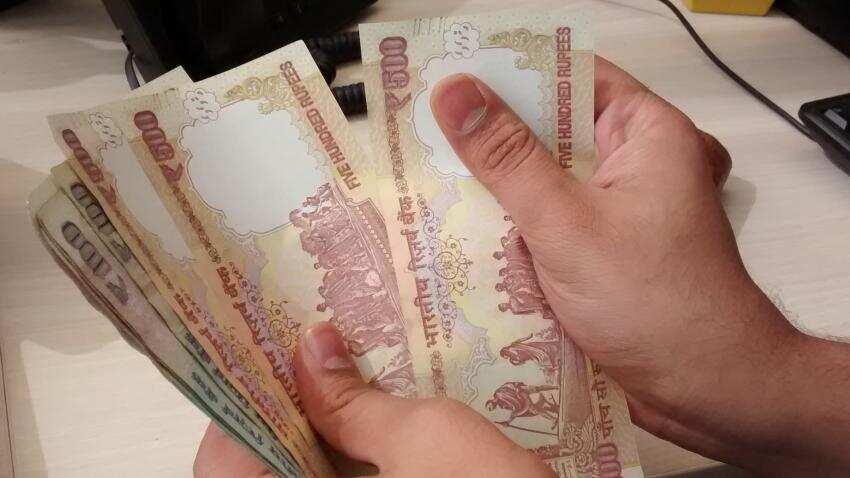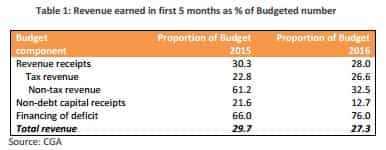Revenue shortfalls: A challenge for govt to achieve fiscal deficit target
Another challenge for the government is garnering resources from disinvestment proceeds which are to be Rs 56,500 crore, the report said.

The total revenue collected in the past five months is lower in 2016 compared with 2015. The revenue shortfalls are likely in non-tax revenue collections and disinvestment, a report said.
The major pressure point is on the side of non-tax revenue where collections have been sluggish. Tax collections on the other hand have been higher this year, a CARE Ratings report said.
For the first five months of the current fiscal, gross tax revenue grew by 21.9% supported by 31.9% increase in income tax, 50.7% in excise, 6.5% in customs and 24.4% in service tax. Corporate tax collections were down by 1.4%.

However, latest data for the six month period indicated that direct tax collections were up by 9% with 39% of the budgeted amount being collected. Corporate tax collections were up by 9.5% and income tax by 16.9%, the report said.
Non-tax revenue: A challenge for government
As per the report, the challenge will be on the side of non-tax revenue where the reports on the sale of spectrum indicated that the total amount involved will be around Rs 66,000 crore, which was just 66% of what was accepted last year. Out of this amount, only half will come in this year.
Madan Sabnavis, Chief Economist, CARE Ratings, in a report titled 'Challenges in Fiscal management', said, "The targeted amount from ‘communications’ which includes this sale is over Rs 40,000 crore higher than that last year at around Rs 98,000 crore. This would put pressure on the revenue receipts. Further, there can be slippages on the dividend paid by the PSBs to the government as they have yet to turnaround and are in the red given the provisions that have to be made for NPAs. The net impact on transfers to the government could be in the range of Rs 1000-2000 crore depending on the final profitability of these banks at the end of the year".
Also, the surpluses from the Reserve Bank of India have been almost at the same level as last year at Rs 65,856 crore, the report added.
Another challenge for the government is garnering resources from disinvestment proceeds which are to be Rs 56,500 crore, the report said. As of August end, only 6% of the target was achieved.
The government had set a target of Rs 20,500 crore for strategic disinvestment while Rs 36,000 crore was expected to come from minority sale of stake. Along with this, shares held by Specified Undertaking of the Unit Trust of India (SUUTI) were to be sold during the fiscal year.
This activity will become critical for the government in balancing the budget especially if the revenue receipts from other sources do not compensate for any such shortfall, Sabnavis said.
Further, the report said that during the first five months of the financial year, the fiscal deficit of the central government was Rs 4.07 lakh crore, which is 76.4% of the projected deficit of Rs 5.33 lakh crore for the year.
Though, it is too early to comment on the numbers as the second installment of advance tax payments were due in September, there are concerns which will put pressure to adhere to the fiscal deficit norm of 3.5% of GDP for FY17, the report added.
"This is important today because the private investment cycle has not yet commenced and there is a lot of dependence on the government to keep the investment tempo stable", the report said.
On the positive side, the rating agency believes that the receipts of the amnesty pursued by the government which had declarations of about Rs 65,000 crore. For instance, assuming tax cum-penalty rate of 45%, the gain could be to the extent of around Rs 30,000 crore, which can compensate of any shortfall as this has not been taken into account in the budgetary calculations.
Thus, there are chances that the slippages on the non-tax revenue and disinvestment could be compensated to an extent by this amount, the report said.
Expenditure challenges
The government has so far been controlling expenditure quite judiciously and has ensured that plan expenditure has been maintained while adjusting the non-plan expenditure with relatively lower spending.
Within plan expenditure, it has been noticed that the sectors as represented by the concerned departments where the government has been aggressive in terms of using up a larger proportion of the budgeted amounts in 2016 compared with the same in 2015.
"The sectors are: urban development (35% to 70%) and Human resources (41% to 52%), while it has come down for rural (63% to 51%), railways (35% to 32%) and remained virtually unchanged for roads (49% to 50%) and health at 43%. In case of non-plan expenditure, there was a reduction in the pace of spending for agriculture (54% to 32%), communications (71% to 56%), defence (39% to 36%) and health (53% to 51%). The conventional pressure points i.e. food, fertilizer and fuel subsidy have been under control with the pace of spending being at the same level as last year".
The rating agency in the report said that Pay Commission commitments can be deferred to an extent in case there are problems with balancing the budget; but this may not be required.
Get Latest Business News, Stock Market Updates and Videos; Check your tax outgo through Income Tax Calculator and save money through our Personal Finance coverage. Check Business Breaking News Live on Zee Business Twitter and Facebook. Subscribe on YouTube.
12:37 PM IST










